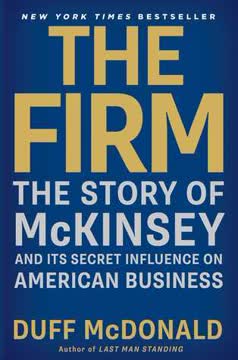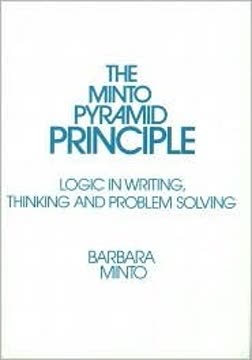Key Takeaways
1. McKinsey's Problem-Solving Approach: Fact-Based, Structured, and Hypothesis-Driven
Facts are the bricks with which you will lay a path to your solution and build pillars to support it. Don't fear the facts.
Fact-based analysis is the cornerstone of McKinsey's problem-solving approach. This method compensates for lack of gut instinct and bridges the credibility gap, especially for young consultants facing seasoned executives. McKinsey consultants gather extensive data before forming hypotheses, ensuring their solutions are grounded in reality.
Structured thinking is embodied in the MECE principle: Mutually Exclusive, Collectively Exhaustive. This approach ensures that all aspects of a problem are considered without overlap, leading to clearer thinking and more comprehensive solutions. McKinsey consultants break down problems into distinct components, analyze each separately, and then synthesize the findings.
Hypothesis-driven problem-solving involves developing an initial hypothesis early in the process. This serves as a roadmap, guiding the team's efforts and focusing their research. However, consultants remain flexible, ready to adjust their hypothesis as new facts emerge.
2. The 80/20 Rule: Focus on What Matters Most
The 80/20 rule is one of the great truths of management consulting and, by extension, of business.
The Pareto Principle states that roughly 80% of effects come from 20% of causes. In business, this often translates to:
- 80% of sales coming from 20% of customers
- 20% of products generating 80% of profits
- 80% of problems stemming from 20% of causes
By identifying these critical 20% factors, consultants can focus their efforts where they'll have the most impact. This principle helps in:
- Prioritizing tasks and resources
- Identifying key customers or products
- Streamlining operations for maximum efficiency
McKinsey consultants apply this rule to data analysis, looking for patterns and concentrating on the most significant factors that drive business performance.
3. Effective Team Building and Management in Consulting
If you make your boss look good, your boss will make you look good. That's the quid pro quo of hierarchy.
Team composition is crucial in consulting. McKinsey selects team members based on a mix of intellectual horsepower and specific skills relevant to the project. The ideal team balances analytical ability with industry experience and interpersonal skills.
Team morale is maintained through:
- Clear communication of goals and progress
- Regular team meetings and updates
- Respect for team members' time and personal lives
- Recognition of individual contributions
Managing hierarchy within the team and with clients is essential. McKinsey operates with a relatively flat structure internally, but consultants must navigate client hierarchies carefully. The key is to make your superiors look good while ensuring your own contributions are recognized.
4. Mastering the Art of Interviewing and Data Gathering
Don't accept "I have no idea"—treat it as a challenge.
Effective interviewing is a core skill for consultants. Key techniques include:
- Preparing a structured interview guide
- Using open-ended questions to encourage detailed responses
- Active listening and note-taking
- Paraphrasing responses to ensure understanding
- Using the "Columbo tactic" for sensitive questions
Data gathering goes beyond interviews. McKinsey consultants leverage:
- Internal databases and previous studies
- Industry reports and academic research
- Client data and internal documents
- Expert interviews and site visits
The goal is to gather comprehensive, fact-based information while avoiding "boiling the ocean" – gathering excessive, unnecessary data.
5. Crafting Compelling Presentations and Charts
Keep it simple — one message per chart.
McKinsey presentations are known for their clarity and impact. Key principles include:
- Structured argument flow (MECE principle)
- Clear, concise messaging
- Limited slides, focusing on key points
- Simple, impactful charts and visuals
Chart design follows specific rules:
- One main message per chart
- Black and white design for clarity
- Minimal use of 3D or complex graphics
- Clear titles that convey the main point
- Proper sourcing and data attribution
The "waterfall chart" is a McKinsey specialty, effectively showing quantitative flows and breakdowns.
6. Building Strong Client Relationships and Implementing Solutions
If your solution is to have a lasting impact on your client, you have to get support for it at all levels of the organization.
Client engagement is crucial for project success. McKinsey consultants:
- Understand and align with the client's agenda
- Keep clients involved throughout the process
- Deliver early "wins" to build enthusiasm
- Tailor communication to different levels of the organization
Implementation is where many consulting projects fail. McKinsey's approach includes:
- Detailed, actionable implementation plans
- Assigning specific responsibilities and deadlines
- Regular follow-ups and progress tracking
- Building buy-in at all levels of the client organization
The goal is not just to provide recommendations, but to ensure lasting, positive change within the client organization.
7. Surviving and Thriving in a High-Pressure Consulting Environment
Take your team's temperature. Talk to your teammates. Make sure they are happy with what they are doing.
Work-life balance in consulting is challenging. McKinsey consultants cope by:
- Finding mentors for guidance and support
- Maintaining a positive attitude towards travel and new experiences
- Efficient packing and travel planning
- Carving out personal time, even on the road
Team morale is crucial in high-pressure environments. Leaders should:
- Regularly check in with team members
- Provide clear direction and purpose
- Show respect for personal time and commitments
- Foster a supportive team culture
Personal organization is key. Consultants rely on:
- Efficient time management tools
- Clear communication with team and clients
- Reliable support staff (e.g., skilled administrative assistants)
8. The McKinsey Way of Recruiting Top Talent
I always looked for analytical thinkers, people who could break apart problems into their components.
McKinsey's recruiting process is intensive and selective. Key elements include:
- Targeting top academic institutions and non-traditional sources
- Using case interviews to assess analytical and problem-solving skills
- Evaluating both intellectual ability and interpersonal skills
Case interviews are a hallmark of McKinsey recruiting. They assess:
- Analytical thinking and problem structuring
- Business judgment and intuition
- Communication and presentation skills
- Ability to work under pressure
Successful candidates demonstrate not just intelligence, but also the ability to break down complex problems, think creatively, and communicate clearly – skills essential for success in management consulting.
Last updated:
FAQ
What's "The McKinsey Way" about?
- Overview of McKinsey's methods: "The McKinsey Way" by Ethan M. Rasiel explores the problem-solving techniques used by McKinsey & Company, one of the world's top strategic consulting firms.
- Focus on business solutions: The book provides insights into how McKinsey consultants think about and solve business problems using structured, fact-based, and hypothesis-driven approaches.
- Practical advice: It offers practical advice for business professionals on how to apply these techniques to improve their own problem-solving skills and business strategies.
Why should I read "The McKinsey Way"?
- Learn from the best: McKinsey & Company is renowned for its strategic consulting expertise, and this book provides a glimpse into their successful methodologies.
- Enhance problem-solving skills: The book offers valuable techniques and frameworks that can be applied to various business challenges, making it a useful resource for professionals.
- Real-world applications: With examples and anecdotes from former McKinsey consultants, readers can see how these methods are applied in real business scenarios.
What are the key takeaways of "The McKinsey Way"?
- Fact-based analysis: Emphasizes the importance of gathering and analyzing data to support business decisions.
- Structured thinking: Introduces the MECE (Mutually Exclusive, Collectively Exhaustive) framework for organizing thoughts and solutions.
- Hypothesis-driven approach: Encourages forming an initial hypothesis to guide problem-solving efforts and testing it with data.
How does McKinsey approach problem-solving?
- Fact-based: McKinsey consultants rely heavily on data to inform their decisions, ensuring that solutions are grounded in reality.
- Structured: They use frameworks like MECE to break down problems into manageable parts and ensure comprehensive coverage.
- Hypothesis-driven: Consultants start with an initial hypothesis, which they refine and test through analysis and research.
What is the MECE framework mentioned in "The McKinsey Way"?
- Definition: MECE stands for Mutually Exclusive, Collectively Exhaustive, a framework used to organize information and ensure all aspects of a problem are covered without overlap.
- Application: It helps in structuring issues and solutions in a clear, logical manner, making it easier to communicate findings and recommendations.
- Benefits: By using MECE, consultants can avoid confusion and ensure that their analysis is thorough and complete.
How does "The McKinsey Way" suggest managing client relationships?
- Engagement: Keep clients involved in the process to ensure their support and buy-in for the solutions proposed.
- Prewiring: Before formal presentations, walk clients through findings to avoid surprises and gain their agreement.
- Tailored communication: Adjust presentations and discussions to suit different levels within the client organization, ensuring clarity and understanding.
What are some effective research tips from "The McKinsey Way"?
- Start with existing resources: Use annual reports and internal databases to gather initial information quickly.
- Look for outliers: Identify data points that stand out to uncover potential issues or opportunities.
- Seek best practices: Learn from top performers in the industry to improve processes and strategies.
How does "The McKinsey Way" recommend conducting interviews?
- Preparation: Write an interview guide to ensure you cover all necessary topics and stay focused.
- Listening: Allow interviewees to speak freely while guiding the conversation to gather relevant information.
- Paraphrasing: Repeat back what you hear to confirm understanding and encourage further discussion.
What are some brainstorming techniques from "The McKinsey Way"?
- Proper preparation: Ensure all team members are familiar with the problem and relevant data before brainstorming.
- Clean slate: Enter brainstorming sessions without preconceptions to encourage fresh ideas and perspectives.
- Structured sessions: Use exercises like the Post-it or flipchart methods to generate and organize ideas effectively.
What are the best quotes from "The McKinsey Way" and what do they mean?
- "Facts are friendly": Emphasizes the importance of relying on data to guide decision-making and problem-solving.
- "Don't boil the ocean": Advises against trying to analyze everything; focus on the most critical aspects of a problem.
- "Hit singles": Encourages consistent, reliable performance over attempting to achieve perfection or grand successes.
How does "The McKinsey Way" suggest managing internal communications?
- Information flow: Keep team members and superiors informed to maintain alignment and morale.
- Effective messaging: Ensure messages are brief, thorough, and structured for clarity and impact.
- Confidentiality: Maintain discretion and security when handling sensitive information.
What is the significance of the 80/20 rule in "The McKinsey Way"?
- Definition: The 80/20 rule suggests that 80% of results come from 20% of efforts, highlighting the importance of focusing on key drivers.
- Application: Identify the most impactful factors in a business problem to prioritize efforts and resources effectively.
- Efficiency: By concentrating on the critical few, businesses can achieve significant improvements with less effort.
Review Summary
The McKinsey Way receives mixed reviews, with ratings ranging from 1 to 5 stars. Positive reviews praise its insights into consulting, problem-solving methods, and structured thinking approaches. Critics find it outdated, lacking depth, and filled with common-sense advice. Some readers appreciate the book's accessibility and practical tips, while others expected more revealing information about McKinsey's inner workings. The book is generally recommended for those interested in consulting or seeking to improve their business problem-solving skills, despite its limitations.
Similar Books










Download PDF
Download EPUB
.epub digital book format is ideal for reading ebooks on phones, tablets, and e-readers.





